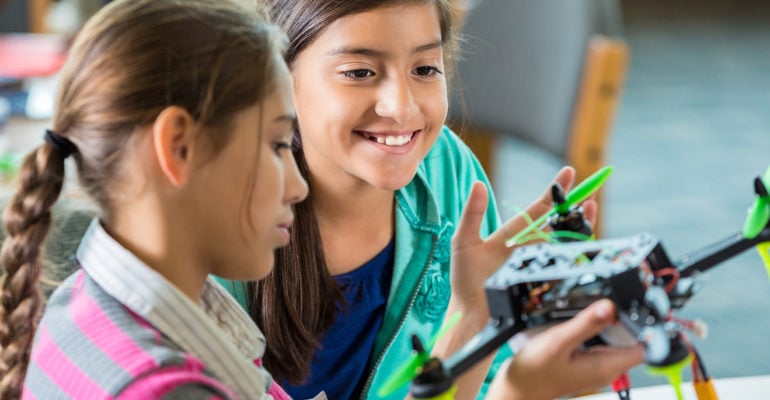STEM education is headed for some interesting changes-and those trends and changes will impact classrooms across the nation.

By @ESN_LAURA
It’s clear to anyone listening that the United States needs more highly-skilled STEM workers to remain globally competitive. And STEM education–including trained STEM teachers–is critical to that goal.
The organization 100Kin10 is working to recruit 100,000 excellent STEM teachers into classrooms across the nation by 2021. 100Kin10 talks to partners and teachers and reviews research and data to understand the challenges and opportunities facing STEM education.
At the end of each year, 100Kin10 boils down its most important data and insights into a list of trends from the past year and predictions for the new year to help inform STEM education moving forward.
1. Supporting students (and especially students of color) by recruiting and supporting teachers of color. Research shows that students of color perform better and reach higher levels of long-term success when they have at least one teacher of color. Despite this research, people of color make up 50 percent of U.S. students, but less than 20 percent of teachers.
2. Two degrees of separation: Improving student success through school leaders. Teachers are the most important in-school predictor of student success, and because principals hire teachers and have a direct impact on school climate and direction. This means school leaders are the second-most important factor in student success. More and more initiatives are popping up to focus on improving school leadership so that school leaders can better support teachers.
3. Innovative strategies for professional development during the school day. U.S. teachers spend much less time in professional development and peer collaboration for STEM education than their international counterparts. This is often due to a lack of time and physical space. More districts are exploring new approaches to PD that give educators more time and opportunity to strengthen their instructional practice.
4. The T in STEM gains prominence: Technology proficiency as a core life skill. Students need hard and soft skills in technology, and they also need digital literacy and technological competency. More programs are focusing on digital literacy as part of teacher preparation, along with ways to help educators evolve their use of technology in classrooms.
5. Expanding strategies for supporting STEM teachers in rural schools. STEM teachers in rural areas often feel isolated and can lack professional connections and opportunities in more populated schools. Efforts are growing to create stronger learning environments in rural schools.
6. Computer science is hot, but there’s a lag in teacher supply. As research shows the lasting and far-reaching impact of computer science education, including strong employability skills like problem solving and collaboration, more states are exploring ways to implement computer science education policies and recruit and retain highly-qualified computer science teachers.
7. STEM will gain prominence in early childhood education. This trend is expected to continue as studies demonstrate how STEM education at an early age positively impacts educational outcomes.
8. Environmental advocacy will engage more youth in STEM. Environmental change protests and teenage activists such as Greta Thunberg are inspiring young people to speak up and take ownership of their education and their politics. In turn, many environmental societies and environmental awareness groups offer educational opportunities tailored to younger learners.
9. STEM teachers will become expert facilitators and curators. Teachers will keep evolving their roles to offer more relevant learning experiences for students. In all areas, but especially in STEM education, students are more apt to retain what they learn if they understand the “why” behind concepts and can link those concepts to real-world scenarios.
10. STEM education will lead the way in authentic and applied learning practices. Students need to build real-world skills while they’re still in school in order to succeed in a global economy. Many organizations and schools are working to give students authentic and real-world learning experiences, such as community service or internships, while they’re still in school.
Source: robotlab.com
Nhiều người cũng xem các bài viết liên quan khác:
>>9 lợi ích mà phương pháp giáo dục stem mang lại
>>Tại sao nên cho trẻ học lập trình Scratch ?
>>[Làm thế nào] Lập trình thú cưng ảo cho bé gái - Tớ học lập trình (cho người mới)
>>[Làm thế nào] Cùng đua xe nào - Tớ học lập trình (cho bé trai)
- Nhận đường liên kết
- X
- Ứng dụng khác
- Nhận đường liên kết
- X
- Ứng dụng khác
Nhận xét
Đăng nhận xét